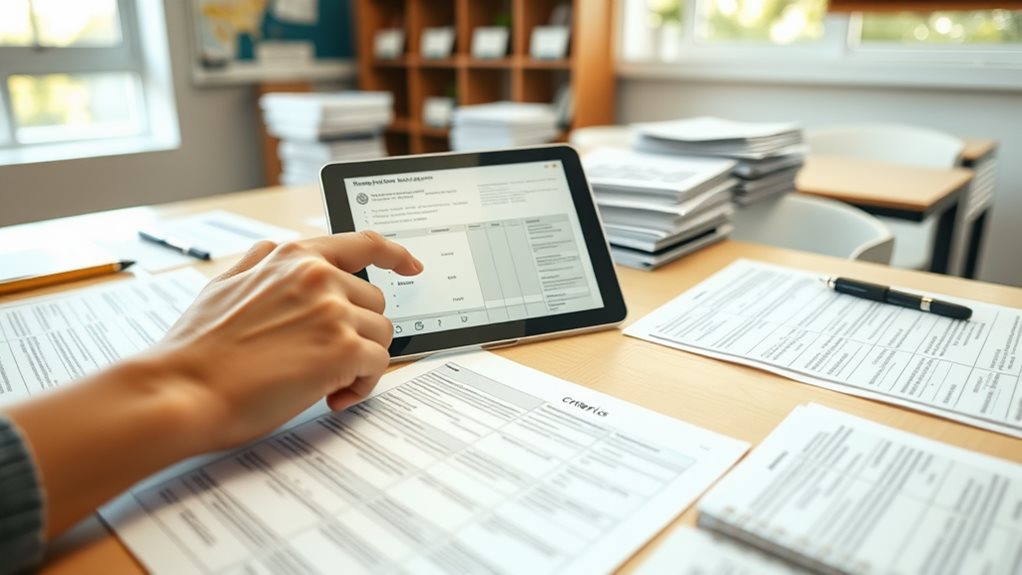Calibrating rubrics ensures you maintain consistent grading standards across all teachers in your school or district. Start by developing clear proficiency scales aligned with curriculum goals, fostering a shared understanding of expectations. Regularly schedule calibration sessions where teachers collaboratively evaluate student work, refining their approach to minimize discrepancies. Analyzing ongoing data helps identify trends and informs instructional adjustments. This practice strengthens collaboration and accountability, creating a culture of fairness and growth. To explore effective strategies further, consider the insights that follow.
Importance of Calibration in Writing Education

Calibrating rubrics for grading isn't just a step in the process—it's the foundation of consistency and fairness in writing education. When you calibrate your team's understanding of effective writing, you ensure that every teacher interprets the rubric the same way. This alignment minimizes discrepancies in grading, whether you're assessing essays across classrooms or even within the same course.
Without calibration, you risk inconsistent feedback that can confuse students and undermine their progress.
Think about it: when your team shares a unified vision of what "proficient" or "advanced" writing looks like, you're not just grading papers—you're building a shared language for discussing student work. This alignment isn't just about fairness; it's about creating a system where students know exactly what's expected of them.
And when expectations are clear, students are more likely to rise to meet them.
Here's why calibration matters:
- Consistency Across Graders: Without calibration, two teachers might score the same essay very differently. Calibration ensures everyone is on the same page, literally and figuratively.
- Validity of Data: If your assessments aren't aligned, the data you collect won't accurately reflect student performance. Calibration ensures your grading is both reliable and valid.
- Improved Feedback: When your team uses a consistent rubric, feedback becomes more actionable. Students receive clear, specific guidance on how to improve.
But calibration doesn't just happen. It requires a structured approach. Start by reviewing normed essays—examples that represent each level of your rubric.
Discuss these samples with your team, aligning your scores and justifying your decisions. This process not only sharpens your grading skills but also fosters a deeper understanding of the rubric itself.
And here's the kicker: calibration isn't a one-and-done task. It's an ongoing practice. As your team grows and evolves, so should your calibration process.
Regular discussions about student work keep everyone aligned and ensure that your grading remains consistent over time.
Steps to Develop Common Proficiency Scales
Developing common proficiency scales is a critical step in ensuring that grading is consistent and meaningful across your district. To start, you need to define specific skill and content expectations. These expectations should be clear, measurable, and aligned with your curriculum standards. Without this foundation, grading becomes subjective, and students may not receive equitable feedback.
Work with your team to identify the core skills and knowledge students must master at each grade level. This ensures that all teachers are on the same page about what proficiency looks like.
Next, establish clear success criteria within these scales. Success criteria break down the broader expectations into actionable steps that students can follow. For example, if the expectation is that students can write a persuasive essay, the success criteria might include constructing a clear thesis, using evidence to support arguments, and organizing ideas logically.
These criteria not only guide your grading but also help students understand exactly what they need to do to succeed.
- Define specific skill and content expectations
- Align expectations with curriculum standards
- Establish clear success criteria
- Break down expectations into actionable steps
A collaborative approach is essential when developing these scales. When teachers work together to create proficiency scales, they build a shared understanding of expectations and foster a sense of unity.
This collaboration also allows for diverse perspectives, ensuring that the scales are comprehensive and realistic. Regularly convene with your team to discuss and refine the scales based on classroom experiences and student performance data.
Communication is key. Make sure these proficiency scales are clearly communicated to students. When students understand the benchmarks they need to meet, they're more likely to take ownership of their learning.
Use examples, rubrics, and consistent feedback to reinforce these expectations. For instance, if a student is working on a science project, provide a rubric that outlines the criteria for a successful experiment, including hypothesis formulation, data collection, and analysis.
Finally, continuously review and refine your proficiency scales. Use student performance data to identify areas where the scales may need adjustment.
Are students consistently struggling with a particular skill? Does the scale accurately reflect what success looks like? Regular review ensures that your scales remain relevant and effective, ultimately improving teaching practices and student outcomes.
Collaborative Creation of Common Assessments

Collaborative creation of common assessments is a game-changer in ensuring consistency and equity in grading. When teachers work together in Professional Learning Communities (PLCs), they bring diverse perspectives and expertise to the table, crafting assessments that align seamlessly with district-wide proficiency scales. This alignment ensures that every student, regardless of their teacher, is evaluated on the same standards, fostering fairness across classrooms.
- Alignment with Proficiency Scales: By developing assessments that mirror established proficiency scales, you create a unified framework for evaluating student performance. This eliminates discrepancies in grading and ensures that all students are held to the same expectations.
- Shared Responsibility: Collaborative efforts mean shared accountability. When teachers collectively design assessments, they take joint ownership of student outcomes, fostering a culture of teamwork and mutual support.
- Data-Driven Adjustments: Regularly analyzing student performance data from these assessments allows you to pinpoint trends and adjust instruction. This targeted approach ensures that you're addressing specific learning needs effectively.
The process not only enhances assessment quality but also strengthens teacher collaboration. By working together, you build a community of practice that prioritizes continuous improvement.
This collaborative model transforms how assessments are created, administered, and analyzed, ultimately benefiting both educators and students.
Regular Calibration Sessions for Teachers
Regular calibration sessions are essential for ensuring that grading practices remain consistent and fair across your team of teachers. Without these scheduled check-ins, discrepancies in how each of you interprets and applies grading criteria can lead to inconsistent student outcomes. By committing to regular calibration, you create a shared understanding of proficiency standards and foster a culture of collaboration that benefits both educators and students.
During these sessions, you'll grade the same sample of student work collaboratively, discussing the reasoning behind your scores. This process allows you to identify and address any inconsistencies in grading. For example, one teacher might grade an essay more leniently on structure, while another might prioritize grammar. By calibrating, you align on what truly matters in the rubric and ensure fairness for all students.
- Discuss and define rubric criteria as a team.
- Grade student work samples together and compare scores.
- Identify gaps in understanding or application of the rubric.
- Collaborate to refine grading practices for consistency.
The urgency of regular calibration can't be overstated. Without it, grading discrepancies can unintentionally disadvantage students, especially when transitioning between classrooms or teachers. By scheduling these sessions throughout the academic year, you maintain alignment and prevent drift in grading standards.
Analyzing student data post-calibration is another critical step. This data helps you identify trends—such as areas where students consistently struggle—and adjust your instructional strategies accordingly. For instance, if multiple teachers notice students underperforming in analytical writing, you can collectively develop targeted interventions to address the skill gap.
Regular calibration isn't just about grading; it's about accountability and growth. It ensures that every student receives equitable treatment and that your team remains aligned in its goals. By prioritizing these sessions, you're not only improving grading practices but also fostering a culture of continuous improvement and shared responsibility for student success.
Analyzing Student Data to Inform Instruction

Analyzing student data after each assessment is your key to unlocking actionable insights that can transform your teaching. When you dive into the numbers, you're not just looking at scores—you're identifying trends and patterns that reveal where they're excelling and where they're struggling. This isn't just about grading; it's about tailoring your instruction to meet their needs.
Start by breaking down the data by student groups. Are certain demographics or skill levels underperforming? This isn't a blame game—it's an opportunity to evaluate the effectiveness of your strategies. If a particular group is consistently lagging, consider adjusting your teaching methods or introducing targeted interventions. For example, if visual learners are struggling with text-heavy material, incorporate more charts or diagrams to bridge the gap.
A data-driven approach also allows you to make real-time adjustments. Suppose you notice a sudden dip in understanding a specific concept after an assessment. Instead of moving forward, you can circle back, re-teach, and reinforce that topic. This flexibility ensures your instruction remains responsive and effective.
But it's not just about the students—it's about you, too. Continuous analysis fosters a culture of reflection and growth. Are your rubrics accurately measuring what you intend? Are your assessments aligned with your learning objectives? By asking these questions, you're not just improving their outcomes; you're refining your craft.
Here's how you can get started:
- Use spreadsheets or grading software to organize and track student performance.
- Identify patterns in errors or misconceptions.
- Compare results across different assessments to gauge progress.
- Collaborate with colleagues to share insights and strategies.
Ultimately, analyzing student data isn't just a post-assessment task—it's a cornerstone of effective teaching. By leveraging this information, you'll not only track progress toward proficiency but also close achievement gaps and ensure every student reaches their potential.
Addressing Challenges in Calibration Practices
Calibration sessions are essential for maintaining consistent grading standards, but they're not without challenges. One common issue is absenteeism, which can disrupt the uniformity of evaluations. When team members miss these crucial sessions, it's easy for discrepancies to creep into the grading process. To mitigate this, establish a practice where absent members receive detailed notes from the session. This ensures everyone stays on the same page, even if they couldn't attend in person.
Time constraints are another frequent roadblock. Collaborative scoring and data analysis require careful attention, and rushed sessions can lead to inconsistent results. One effective solution is to leverage a collaborative whiteboard app. These tools allow educators to work together in real time, even when they can't be in the same room. You'll save time while maintaining the depth of discussion needed for accurate calibration.
- Use a shared digital platform to track scoring progress
- Allocate specific time blocks for deeper analysis
- Encourage asynchronous contributions when schedules clash
Differences in scoring between teachers underscore the need for regular calibration. One educator might interpret a rubric element differently than another, leading to inequitable grading practices. Consistent calibration sessions help bridge these gaps, fostering a shared understanding of proficiency standards. When you notice discrepancies, use them as teaching moments. Discuss why the differences occurred and how to align interpretations moving forward.
It's also critical to recognize that calibration isn't a one-and-done activity. Discrepancies may still arise, even after thorough sessions. When they do, don't panic—it's a natural part of the process. Instead, develop a plan for addressing consistently uncalibrated appraisers. This could involve targeted training, peer mentoring, or additional practice scoring sessions. The goal is to bring everyone into alignment without discouraging growth.
Regular calibration activities are your best tool for fostering gradual alignment. Over time, these sessions build a shared language and understanding among educators. They also provide opportunities for continuous improvement. By engaging in these practices consistently, you'll see a noticeable increase in grading accuracy and fairness across your team.
- Schedule calibration sessions quarterly or bi-annually
- Create a feedback loop to address recurring issues
- Celebrate progress to motivate ongoing participation
Ultimately, calibration is about more than just grading accuracy. It's about creating a culture of collaboration and mutual respect. When educators come together to align their practices, students benefit from a more equitable and transparent evaluation process. So, invest the time and effort into refining your calibration practices—the results will speak for themselves.
Impact of Calibration on Teacher Collaboration

Calibrating rubrics for grading isn't just about scoring—it's a transformative process that strengthens teacher collaboration. When you engage in calibration sessions, you're not working in isolation; you're building a shared understanding of proficiency scales with your peers. This alignment ensures that expectations are communicated clearly and consistently to students across classrooms.
Regular calibration sessions foster deeper discussions about grading practices. You'll notice discrepancies in how different teachers interpret rubrics, and through collaboration, you can address these inconsistencies. This process creates a culture of respect and equity in scoring, ensuring all students are evaluated fairly.
Here's how calibration enhances collaboration:
- Shared Standards: Developing common assessments ensures that every student is evaluated on the same criteria, reinforcing a unified approach to education.
- Open Dialogue: Respectful disagreements during calibration sessions lead to more equitable grading practices and a commitment to high-quality teaching.
- Data-Driven Adjustments: After assessments, analyzing student data collaboratively allows you to refine instructional strategies and adapt teaching methods based on collective insights.
Calibration transforms grading from a solitary task into a team effort. By working together, you'll not only improve grading accuracy but also strengthen the professional community within your school.
It's an urgent step toward ensuring every student receives the education they deserve.
Tools and Strategies for Efficient Calibration
Utilizing collaborative whiteboard apps can transform how you conduct virtual calibration sessions. These tools allow you to share student work in real time, annotate documents collectively, and engage in dynamic discussions—no matter where your team is located. Platforms like Miro or Jamboard enable you to create a shared space where you can analyze rubrics side by side, ensuring everyone is on the same page. This approach not only saves time but also fosters consistency in grading by making discrepancies visible and easy to address.
Regular calibration meetings are essential for maintaining inter-rater reliability. During these sessions, focus on discussing student work samples openly. Bring in assignments that represent varying levels of proficiency and have teachers score them independently before sharing their reasoning. This process highlights differences in interpretation and provides a clear starting point for alignment. By making these discussions a routine part of your professional development, you'll strengthen your team's ability to apply rubrics consistently.
- Use collaborative whiteboard apps for real-time annotation and discussion.
- Share student work samples to identify and address discrepancies.
- Schedule regular calibration meetings to maintain consistency.
- Encourage independent scoring followed by group discussions.
Incorporating co-observation protocols is another powerful strategy for aligning scoring. Arrange for appraisers to observe the same lesson, either in person or via video, and then compare their ratings using a shared rubric. This practice allows you to pinpoint where interpretations diverge and address those areas through focused dialogue. Co-observation not only improves calibration but also builds trust and mutual understanding among your team.
Developing common proficiency scales across your district is a game-changer. These scales provide a clear, shared understanding of what proficiency looks like at each level, reducing ambiguity in grading. Involve teachers in creating these scales to ensure buy-in and relevance. Once established, they serve as a foundational tool for calibration, professional development, and student feedback. A unified framework ensures that "proficient" means the same thing in every classroom.
During calibration activities, emphasize evidence-based discussions. Teach your team to differentiate between high-quality and low-quality evidence when scoring student work. This skill elevates the precision of your assessments and minimizes rating disagreements. Use examples to illustrate what constitutes strong evidence and guide teachers in applying this criterion consistently. By sharpening this focus, you'll enhance the integrity of your grading process and better support student learning.
Role of Rubrics in Promoting Consistent Grading

Rubrics are essential tools for ensuring consistent grading across your classroom or even your entire school. When you use rubrics, you establish clear, detailed criteria that define what success looks like, leaving little room for subjective interpretation. This clarity not only makes your grading more reliable but also builds trust among students, parents, and colleagues.
Analytic writing rubrics, in particular, break down writing into specific components—like organization, vocabulary, and grammar—allowing you to assess each element separately. By doing this, you create a shared language among educators about what constitutes effective writing. This shared understanding is critical for maintaining consistency, especially when multiple teachers are evaluating the same work.
Here's how rubrics promote consistency:
- They provide explicit expectations, so every teacher knows exactly what to look for.
- They reduce bias by focusing on objective criteria rather than personal impressions.
- They ensure students are evaluated fairly, regardless of who's grading their work.
Calibration sessions are another crucial step in maintaining this consistency. When you and your colleagues come together to discuss rubric scoring, you identify and resolve any discrepancies in interpretation. These sessions help you develop a shared vision of student success and ensure that everyone applies the rubric in the same way.
By using student-friendly language in your rubrics, you also empower your students to take ownership of their learning. When they understand exactly what's expected of them, they can better track their progress and work toward meeting those standards. This transparency fosters a growth mindset and aligns everyone—teachers and students alike—around common goals.
Ultimately, the role of rubrics in consistent grading is about fairness and equity. When you calibrate your rubrics and apply them consistently, you create a grading system that's transparent, reliable, and designed to help every student succeed.
Professional Development for Continued Improvement
Professional development focused on grading calibration is essential for ensuring consistency and fairness across classrooms. You know that when teachers interpret rubrics differently, it can lead to discrepancies in grading that impact student outcomes. By engaging in regular calibration sessions, you're not just aligning scores—you're building a shared understanding of what proficiency looks like.
- Collaborative calibration sessions bring teachers together to review and score sample student work. This process exposes differences in interpretation and provides a space to discuss and align on expectations.
- Ongoing training ensures that teachers stay updated on best practices for using rubrics and providing constructive feedback. This isn't a one-time event; it's a continuous journey of improvement.
- Reflection on student work during these sessions helps teachers identify patterns in their grading and adjust their instructional strategies to better meet student needs.
When you prioritize professional development for calibration, you foster a culture of collaboration and accountability. Your team becomes more consistent in their grading, which directly benefits students by providing clearer feedback and more accurate assessments of their progress.
This isn't just about improving scores—it's about supporting student growth and ensuring fairness in evaluation. Incorporating these practices into your professional development plan doesn't just improve inter-rater reliability; it also empowers teachers to refine their instructional approaches.
Questions and Answers
What Is Grading Calibration?
Grading calibration ensures you apply grading standards consistently through teacher collaboration. You and your peers assess student work together, refine rubric development, and align expectations, enhancing fairness and accuracy in evaluating student performance across classrooms.
How Can Scoring Guides or Scoring Rubrics Help Teachers to Make Scoring More Reliable?
Scoring guides or rubrics enhance scoring consistency by providing clear evaluation criteria. Through rubric development, you break down assignments into specific elements, ensuring objectivity. Teacher collaboration during calibration fosters alignment, reducing grading discrepancies and improving reliability.
Which Type of Rubric Is Mostly Used by the Teachers?
You'll find that teachers mostly use analytic rubrics because they break down criteria like organization and diction for detailed feedback. While holistic rubrics offer efficiency, and task-specific rubrics target precise tasks, analytic ones remain versatile and widely favored.
When Should Teachers Use Rubrics as a Grading Tool?
Use rubrics during formative and summative assessments to maximize rubric effectiveness and ensure grading consistency. Apply them when teacher collaboration enhances inter-rater reliability, providing clear criteria, reducing subjectivity, and promoting transparent, actionable feedback for student improvement.
